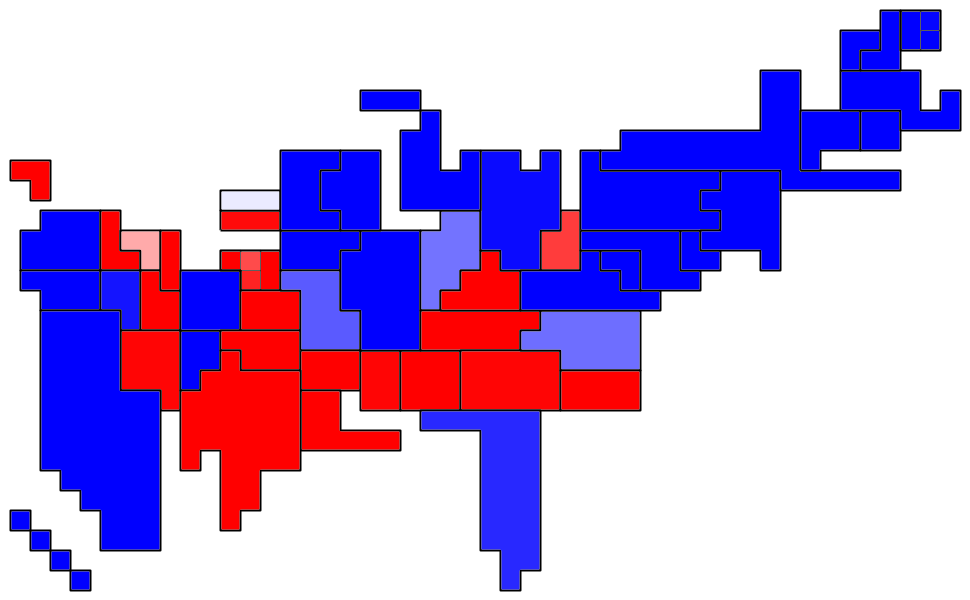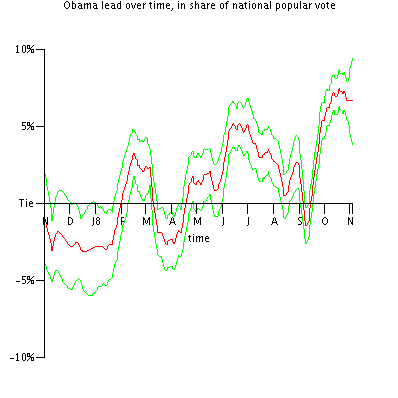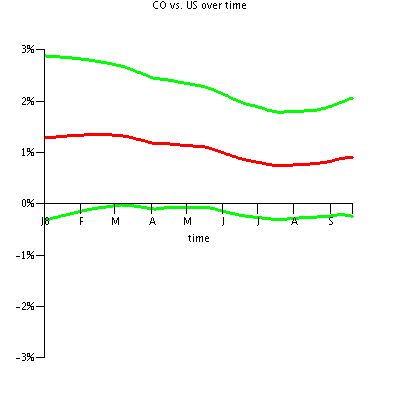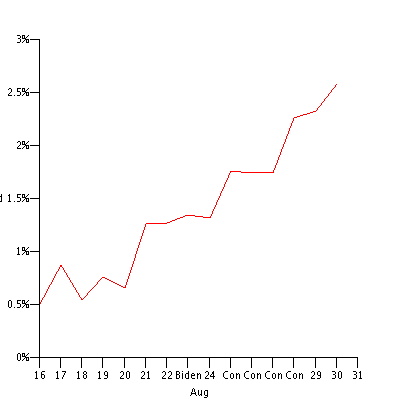Current polling shows an extremely tight race that John McCain probably leads. If the election were today, I would predict a 67.5% chance of a McCain victory, a 27.5% of an outright Obama victory, and a 5% chance of on Obama victory through an electoral tie. Given my uncertainty about future changes in public opinion, I have the race as almost a total tossup.
I hope that the Obama camp will use this opportunity to take a hard look at which states are true swing states, in other words, those likely to make a difference in a close election. The states that are close right now -- CO, OH, MI, NM, PA, NV, VA, WI -- are the states that will determine the election. That means that these are the states to focus on, even if states like IN look winnable (as it did a few weeks ago) or if states like MN look loseable (as may come to pass).
It drives me crazy when I turn on the TV and see Obama stumping in Terre Haute (IN) as he did a week ago. There's nothing wrong with Terre Haute, except that it's just about the farthest in Indiana that one can physically get from a swing state. If Obama wants to stump in a population center the size of Terre Haute, he should choose Battle Creek (MI) or Lima (OH) or Altoona (PA) or Longmont (CO) or Santa Fe (NM) or Charlottesville (VA) or Oshkosh (WI) or Carson City (NV).
Neither campaign really gets this, and both are wasting time in states that don't matter. Just compare Obama's and McCain's public schedules from 8/5 to 9/5, with states ordered by a measure of relative usefulness (swinginess of the state, divided by population):
| State | Obama visits | McCain visits | Usefulness |
|---|
| NM | 1 | 1 | 4.57 |
| NV | 1 | 0 | 3.44 |
| CO | 2 | 1 | 2.75 |
| MI | 1 | 2 | 0.98 |
| OH | 1 | 4 | 0.82 |
| VA | 2 | 0 | 0.65 |
| PA | 2 | 4 | 0.48 |
| WI | 1 | 1 | 0.40 |
| IA | 1 | 1 | 0.17 |
| MO | 1 | 1 | 0.12 |
| IN | 1 | 0 | 0.10 |
| MT | 1 | 0 | 0.10 |
| MN | 1 | 2 | 0.05 |
| FL | 1 | 1 | 0.02 |
| Others | 4 | 4 | 0.00 |
Both candidates are spending half their visits in places that don't matter.
What I find interesting is the very different ways that the two campaigns have allocated their visits to states that do matter. Obama is making more visits to smaller swing states (NM, NV, CO, VA) while McCain is making more visits to larger swing states (OH, PA, MI). The trade-off is this: 1) Changing the result in a large state is more important to the Electoral College than changing the result in a small state, but 2) it's much easier to change the result in a small state because you have to sway fewer people. Obama's bet is that A) because of how the electoral math works out this year, certain small states are as important as many large states, and B) a visit to a large state will sway only as many voters as a visit to a small state. Point (A) is a bet that part (1) of the trade-off is not so important, and point (B) is a bet that part (2) of the trade-off is accurate. On the other hand, McCain's bet is that A') even if it looks like CO is as important as OH/PA/MI at a point in time, he can swing OH/PA/MI enough to put the election out of reach, and B') a visit to a large state will sway many more voters as a visit to a small state because of more widespread media coverage. Point (A') is a bet that part (1) of the trade-off is very important, and point (B') is a bet that part (2) of the trade-off is inaccurate because of efficiencies to campaigning in large states.
It's interesting to me how the candidates have made these very different bets, and I'm excited to see how they play out. It's not clear who's right, but I tend to think that Obama's bets are better.
First, let's look at whether large states are really more important than small states this year. As I've said many times before, public opinion changes in different states are highly correlated, meaning that blue-to-red ranking of WI-PA-(NH/MI/NM)-CO-(OH/NV)-VA is likely to remain stable through the rest of the race. This means that WI will be bluer than PA, PA will be bluer than NH/MI/NM, NH/MI/NM will be bluer than CO, and so on. If this ranking holds up, then CO will be the key state, despite its small size. If this ranking holds up with one transposition, then CO, MI, NM, OH, or NV will be the key state. What's clear here is that size doesn't matter -- small states like CO/NM/NV are as important as big states like MI/OH/PA. Because of this, I agree with Obama's bet (A) rather than McCain's bet (A').
Of course, if you believe that states are loosely correlated, then the current ordering of states doesn't matter much, and so OH/MI/PA are clearly more important.
Second, let's look at whether campaigning in large states is more efficient than campaigning in small states, as the McCain campaign believes. This would be the case if vastly more people saw the earned media from a visit to a large state than from a visit to a small state because the population centers there are bigger. I think that this is wrong. The thing that really matters is the size and extent of a media market. Because CO/NV/NM are dominated by one media market each, I think that a visit to CO/NV/NM will sway almost as may votes as a visit to PA/OH/MI. Put another way, Philadelphia may have 3 times the people as Denver, but its media market covers barely as many Pennsylvanians as Denver's covers Coloradans, and as a percentage of state population, it is far smaller than Denver's.
Conclusion: I think that Obama has the right strategy of focusing in smaller swing states, but he needs to stop wasting time in places like Terre Haute.
[Edited to add: Jerome Armstrong makes a nice comment about how Obama is wasting field resources too in states that aren't going to turn this election. I think field is even more important than earned media, so this concerns me.
Labels: campaign visits, focus, strategy, terre haute
Read more (maybe)!










